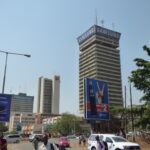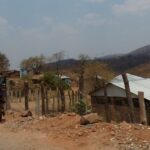An afternoon at the pool (and a wifi connection) gives me the chance to share a bit of my (newly acquired) knowledge:
- Zambia has one of the fastest growing populations in the world. Since 1950, the population has increased sevenfold to 17 million and will double again by the middle of the century. At the same time, Zambia is one of the countries with the highest HIV infection rate. Life expectancy fell from 60 (in 1990) to about 40 years (in 2005). Approximately one million AIDS orphans are living in Zambia – that is every fifth child, of which only a few receive school education and ten percent are without a home.
- The copper industry is THE country’s main source of income (although 80% of the population are still employed in agriculture). And the decline in copper prices and production was one reason for Zambia’s economic downturn. In rural areas in particular, over 60 per cent of the population still live on less than one dollar a day. Malnutrition among children and nursing mothers is widespread and infant mortality is high.
- With its geographical location within Africa, Zambia has traditionally been closely linked to the issues of migrants, refugees, and internally displaced persons.
- After several clever treaties by Cecil Rhodes, the area became part of the British Crown as Northern Rhodesia until independence in 1964. In contrast to many neighbouring states, independence took place without violent clashes and till today life is not dominated by racial problems.
- The landlocked state is situated away from the major African tourist destinations. Its name derives from the Zambezi River, which forms the southern border to Namibia, Botswana and Zimbabwe. The second large river system forms the Congo to the north.
Ein Nachmittag am Pool gibt mir die Gelegenheit, mit meinem neu erworbenen Wissen etwas anzugeben – und auch in Themen einzuführen, auf die ich später noch zurückkomme:
- Sambia hat eine der am schnellsten wachsenden Bevölkerungen weltweit. Seit 1950 hat sich die Einwohnerzahl auf 17 Mio versiebenfacht und wird sich bis Mitte des Jahrhunderts noch einmal verdoppeln. Gleichzeitig gehört Sambia zu den Ländern mit der höchsten HIV-Infektionsrate. So ging die Lebenserwartung von 60 (im Jahr 1990) auf etwa 40 Jahre (2005) zurück. Man rechnet mit rund einer Million AIDS-Waisen in Sambia – das ist jedes fünfte Kind, von denen die wenigsten eine Schulausbildung erhalten und zehn Prozent obdachlos sind.
- 80 % der Bevölkerung sind in der Landwirtschaft beschäftigt aber der Bergbau (Kupfer) ist DIE Haupteinnahmequelle des Landes. Gesunkene Kupferpreise und -mengen waren ein Grund für Sambias wirtschaftlichen Rückgang. Vor allem in ländlichen Gebieten leben über 60 % der Bevölkerung auch heute noch von weniger als einem Dollar pro Tag. Unterernährung bei Kindern und stillenden Müttern ist weit verbreitet, die Kindersterblichkeit hoch.
- Mit seiner geografischen Lage innerhalb Afrikas hat Sambia schon traditionell viele Flüchtlinge, Vertriebene und Migranten.
- Nach mehreren cleveren Verträgen von Cecil Rhodes kam das Gebiet zur britischen Krone und blieb als Nordrhodesien bis zur Unabhängigkeit 1964 britisch. Die Unabhängigkeit verlief anders als in vielen Nachbarstaaten ohne gewalttätige Auseinandersetzungen. Ein Grund, weshalb Rassenprobleme in Sambia nie die Innenpolitik prägten und kein Gegensatz zwischen Schwarz und Weiß konstruiert wurde.
- Der Binnenstaat im südlichen Afrika liegt abseits der großen afrikanischen Reiseziele. Sein Name leitet sich vom Fluss Sambesi ab, der die Südgrenze zu Namibia, Botswana und Simbabwe bildet. Das zweite große Flusssystem bildet nach Norden hin der Kongo.






Schreibe einen Kommentar